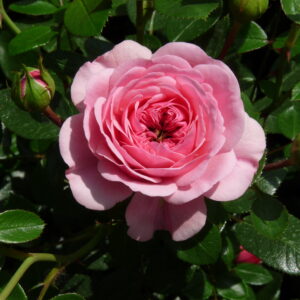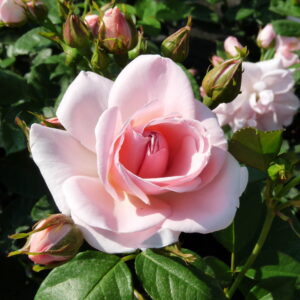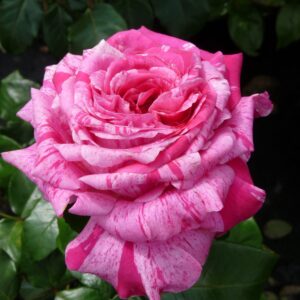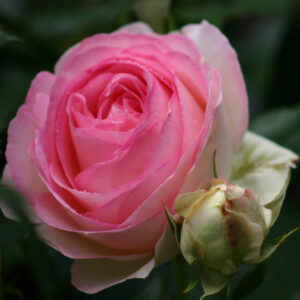Special Offer, Climbing Roses XXL potted
Special Offer, XXL Climbing Roses potted
Bare root roses can be planted between October and the end of April.
Roses in container pots can be planted all year round, provided the soil is frost-free.
Roses grow in almost any garden, as long as the soil is well worked and contains the necessary nutrients. Digging the soil and applying organic fertilizers such as cow manure, dried cow manure or compost is good for all types of soil. On light sandy soil, the organic fertilizer decomposes much faster than on heavy clay soil, you have to take this into account when planting.
Wet potted roses well before planting. Dig a planting hole that is well larger and deeper than the pot the rose is planted in and carefully remove the pot. Place the complete root ball level with the soil surface and fill the planting hole with soil. Press the soil down well and water generously. Continue to water freshly planted pot roses regularly. Never plant at extremely high temperatures.
Bare-rooted roses are best placed in a bucket of water for a few hours before planting. Make sure that the soil is well prepared and moist. Shorten the root ends slightly before planting. Then, with a good spade, make a v-shaped slot in which the roots of the rose are placed perpendicularly downwards. The rose bud should be placed just below the surface of the earth. Firmly compact the soil and water well.
Fertilization
If you plant roses in the autumn, it is wise to mound the roses with soil or old manure for 10-15 cm. In this way, the roses are protected against a possible severe winter. Remove this soil again in the spring. You can also use dried cow manure to fertilize your roses in the autumn/winter. Check the packaging for the correct amount. This fertilizer is slow-acting.
Rose fertilizer may be given from the beginning of April. This is an active fertilizer. This may be repeated after the first flowering period. No fertilizer should be given after mid-July, so that the roses can ripen well. It is also good to spread lime once a year in the autumn and kieserite (= magnesium) in the spring.
Leaf diseases
Leaf diseases such as sooty mold, rust, powdery and downy mildew are often caused by an unfavorable location, lack of nutrition, over-fertilization and bad weather conditions. With these fungal diseases it is important that you remove fallen and affected leaves and that you spray preventively as soon as the roses start to sprout in March/April. To prevent resistance, change agents regularly. Never spray in the sun (due to fire damage) and on wet leaves. It is best to spray in the evenings.
It is also important that you do not scatter wood chips between your roses (to keep your bedding free of weeds).
This causes a disturbed PH value (acidity) of the soil and this ensures that the roses do not develop properly and can even die.
Roses in container pots can be planted all year round, provided the soil is frost-free.
Roses grow in almost any garden, as long as the soil is well worked and contains the necessary nutrients. Digging the soil and applying organic fertilizers such as cow manure, dried cow manure or compost is good for all types of soil. On light sandy soil, the organic fertilizer decomposes much faster than on heavy clay soil, you have to take this into account when planting.
Wet potted roses well before planting. Dig a planting hole that is well larger and deeper than the pot the rose is planted in and carefully remove the pot. Place the complete root ball level with the soil surface and fill the planting hole with soil. Press the soil down well and water generously. Continue to water freshly planted pot roses regularly. Never plant at extremely high temperatures.
Bare-rooted roses are best placed in a bucket of water for a few hours before planting. Make sure that the soil is well prepared and moist. Shorten the root ends slightly before planting. Then, with a good spade, make a v-shaped slot in which the roots of the rose are placed perpendicularly downwards. The rose bud should be placed just below the surface of the earth. Firmly compact the soil and water well.
Fertilization
If you plant roses in the autumn, it is wise to mound the roses with soil or old manure for 10-15 cm. In this way, the roses are protected against a possible severe winter. Remove this soil again in the spring. You can also use dried cow manure to fertilize your roses in the autumn/winter. Check the packaging for the correct amount. This fertilizer is slow-acting.
Rose fertilizer may be given from the beginning of April. This is an active fertilizer. This may be repeated after the first flowering period. No fertilizer should be given after mid-July, so that the roses can ripen well. It is also good to spread lime once a year in the autumn and kieserite (= magnesium) in the spring.
Leaf diseases
Leaf diseases such as sooty mold, rust, powdery and downy mildew are often caused by an unfavorable location, lack of nutrition, over-fertilization and bad weather conditions. With these fungal diseases it is important that you remove fallen and affected leaves and that you spray preventively as soon as the roses start to sprout in March/April. To prevent resistance, change agents regularly. Never spray in the sun (due to fire damage) and on wet leaves. It is best to spray in the evenings.
It is also important that you do not scatter wood chips between your roses (to keep your bedding free of weeds).
This causes a disturbed PH value (acidity) of the soil and this ensures that the roses do not develop properly and can even die.
Those who love roses should not be too afraid to prune. Regular pruning is important to keep your rose vigorous and healthy.
The more vigorously you prune your roses, the more beautiful and stronger they become and you can enjoy these beautiful flowers again!
After the frost period (about mid-March) the most important pruning should be done. It is important that you use sharp secateurs for this.
Prune all weak and dead wood as well as thin and unripened branches completely into the living wood. Also remove the wild shoots that grow from the bottom of the breeding. Leave the healthy strong branches and grow them to about 5 cm. cut back above the ground.
Prune back large-flowered, truss and miniature roses to just above the second outer eye counting from below.
Standard roses are pruned in the same way as the large-flowered and spray roses.
Weeping stem roses are pruned back once every two years.
In principle, botanical and shrub roses do not need to be pruned back, only a rejuvenation pruning every few years is sufficient. These roses bloom on the old wood.
Do not prune back the main branches of Climbing roses for the first few years. However, annually prune the side branches of main branches that have flowered to 5 cm. Later, regularly prune back one or a few old main branches to 15 cm above the ground to rejuvenate.
Rambler roses don't need pruning at all, except when they get too big and for rejuvenation.
It is also important that you prune your roses regularly during the flowering season. We advise you to prune your roses half back after each flowering period, so that the strength remains in the plant and this promotes reblooming.
Do not prune once blooming roses and roses planted for their hips.
Almost all roses are bred on a 'foreign' rootstock (with the exception of roses on their own roots). From this rootstock, 'wild shoots' occasionally grow. These wild shoots always grow from the bottom of the breeding and stand out because of their different color and leaf shape. These should be completely removed. This also applies to standard roses.
The more vigorously you prune your roses, the more beautiful and stronger they become and you can enjoy these beautiful flowers again!
After the frost period (about mid-March) the most important pruning should be done. It is important that you use sharp secateurs for this.
Prune all weak and dead wood as well as thin and unripened branches completely into the living wood. Also remove the wild shoots that grow from the bottom of the breeding. Leave the healthy strong branches and grow them to about 5 cm. cut back above the ground.
Prune back large-flowered, truss and miniature roses to just above the second outer eye counting from below.
Standard roses are pruned in the same way as the large-flowered and spray roses.
Weeping stem roses are pruned back once every two years.
In principle, botanical and shrub roses do not need to be pruned back, only a rejuvenation pruning every few years is sufficient. These roses bloom on the old wood.
Do not prune back the main branches of Climbing roses for the first few years. However, annually prune the side branches of main branches that have flowered to 5 cm. Later, regularly prune back one or a few old main branches to 15 cm above the ground to rejuvenate.
Rambler roses don't need pruning at all, except when they get too big and for rejuvenation.
It is also important that you prune your roses regularly during the flowering season. We advise you to prune your roses half back after each flowering period, so that the strength remains in the plant and this promotes reblooming.
Do not prune once blooming roses and roses planted for their hips.
Almost all roses are bred on a 'foreign' rootstock (with the exception of roses on their own roots). From this rootstock, 'wild shoots' occasionally grow. These wild shoots always grow from the bottom of the breeding and stand out because of their different color and leaf shape. These should be completely removed. This also applies to standard roses.








